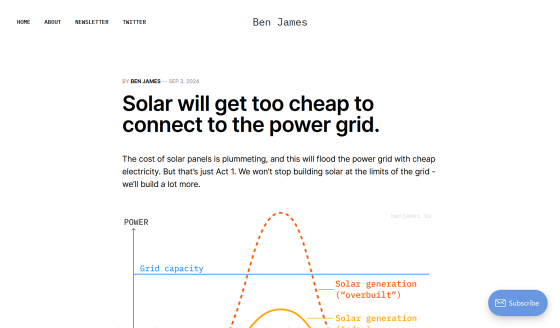Experts point out that if the cost of solar power generation continues to fall, it will not be possible to connect solar panels to the power grid

In recent years, as
Solar will get too cheap to connect to the power grid.
https://climate.benjames.io/solar-will-get-too-cheap-to-connect-to-the-power-grid/

The cost of solar power generation is falling
Solar power generation is a method of generating electricity using sunlight that falls on the earth's surface, and there is no need to store fuel together with the solar panels required for power generation, and the number of moving parts in the solar panels themselves is minimal. Therefore, solar panels are overwhelmingly easier to mass-produce than other power generation devices, and as production volume increases, manufacturing costs continue to fall.
The graph below, posted on the blog of physicist and entrepreneur Dr. Casey Handmer , shows the cost per watt of electricity (in US dollars) on the vertical axis and the cumulative solar power generation in megawatts worldwide on the horizontal axis. As the amount of electricity generated worldwide increases, the cost required to generate 1 watt of electricity becomes cheaper.
The installation of solar panels is also accelerating, with most of the world's solar panels having been installed in the past 30 months. In fact, China, the world's leading solar panel manufacturer,
The graph below shows the amount of solar power generation capacity added in a year, with the installation of solar panels exponentially increasing in 2023. In the UK in 2024, it will be possible to buy a solar panel of the same size for about twice the price of a garden fence.

◆ Solar panels cause saturation of the power grid
At the time of writing, most solar panels are connected to the public power grid, which means that the electricity they generate can be sold to power companies and then distributed to other homes and facilities via the power grid.
However, James points out that as the cost of installing solar panels decreases and more panels are deployed, it becomes more difficult to connect new solar panels to the power grid. One reason for this is that 'solar panels compete with each other.'
All solar panels generate electricity when the sun is out, but the amount of electricity generated decreases in the early morning and evening when there is little light, and at night when there is no sun at all. This causes a phenomenon in which electricity generation increases during the day on sunny days, causing electricity prices to fall, and electricity prices to rise at night. The more solar panels you have, the more this phenomenon accelerates. Eventually, you will reach a point where you have too many solar panels and installing new ones will only result in a loss.
If solar power generation becomes widespread and a large amount of energy becomes surplus, it is said that there is a possibility that a situation will occur in which 'the more electricity you consume, the more you will be rewarded.' In addition, James points out that a drop in electricity prices or a negative price will create an 'incentive to shift existing energy sources to electricity.'
As solar power generation becomes more widespread, we may see an era in which the more electricity we consume, the more rewards we get - GIGAZINE

In addition, while it is easy to install solar panels and build a solar power generation facility, there is also the problem that it takes time to connect it to the power grid. In the UK, the average waiting time to connect a new solar power generation facility to the power grid is already more than five years, and it is estimated that 40% of solar power generation facilities planned for construction will not be connected to the power grid until after 2030.
◆What to do with solar panels that cannot be connected to the power grid?
If you cannot connect new solar panels to the power grid, you will have to use the electricity generated by the solar panels off-grid. In other words, you will only consume the electricity yourself. To use electricity off-grid, you can either 'charge the battery and use it when you want to' or 'use a lot of electricity during the hours when you can generate electricity.'
First, regarding the method of 'charging the battery and using it when you want to use it,' the price of lithium-ion batteries, like that of solar panels, is getting cheaper every year , so it is a cost-effective and realistic method. At the time of writing, much of the electricity sent from solar power generation facilities to large batteries goes through part of the local power grid, but solar panels that cannot be connected to the power grid must be connected directly to the battery. This means that the solar panels and batteries are located in the same place.
The next option is to use a large amount of electricity during the hours when it can be generated. With this method, you can only use abundant electricity for about a quarter of the day, but since you don't even need a battery, the cost is quite low, and in sunny places you can use electricity for free.
'Using electricity' here does not only mean using it to operate factories and facilities, but also to produce energy sources such as synthetic kerosene for airplanes, clean ammonia for fertilizer, clean methanol, and synthetic natural gas. To produce these synthetic fuels, green hydrogen produced in a way that does not emit carbon dioxide is required. The production of green hydrogen is extremely costly, but the adoption of off-grid solar panels is said to be a promising option to increase cost competitiveness.
James pointed out that one of the most important and unsolved questions in the future of energy is, 'Can we build a process that uses free energy a quarter of the time?' This seems like a difficult challenge because cutting the operating time by a quarter would worsen the payback period of a capital-intensive process. However, James argued that this problem has not yet been seriously considered, and that now is the time to start designing a process that uses free energy intermittently.
Related Posts:
in Science, Posted by log1h_ik







